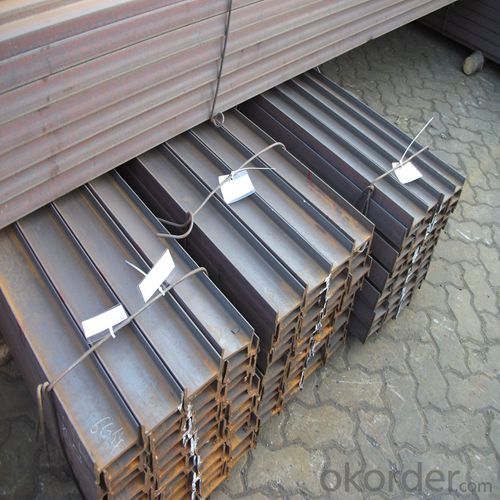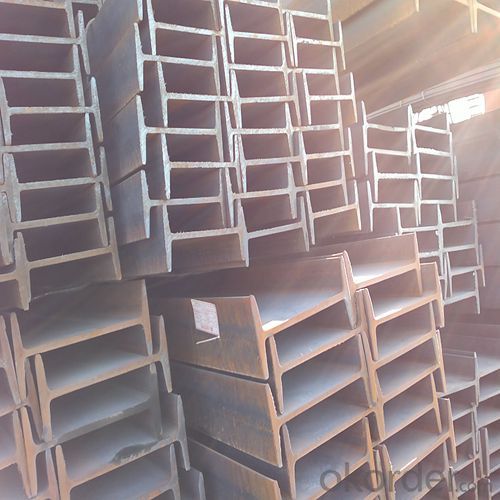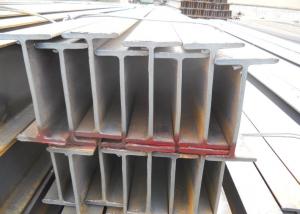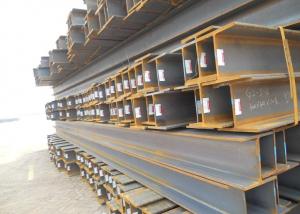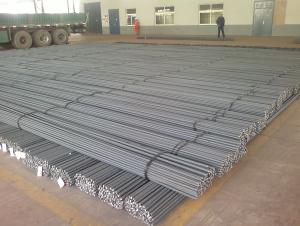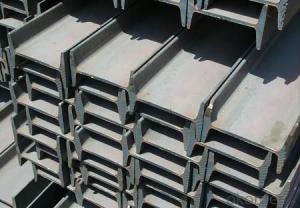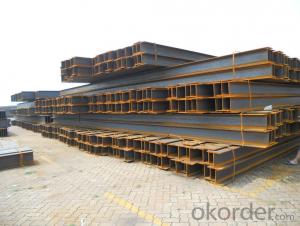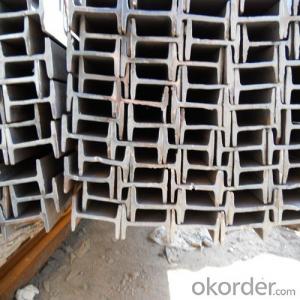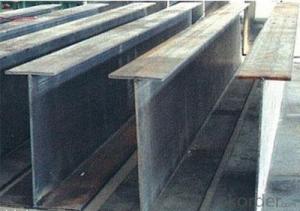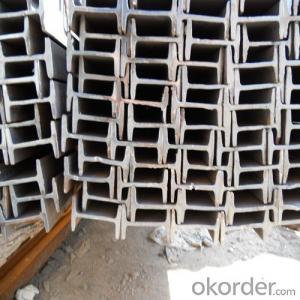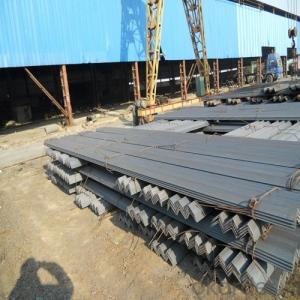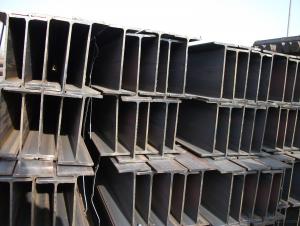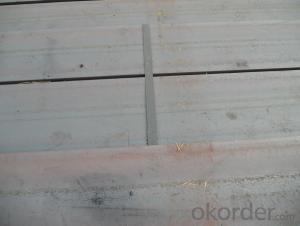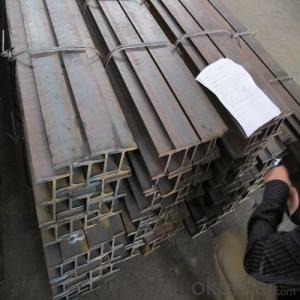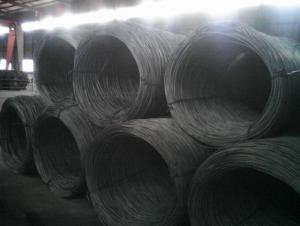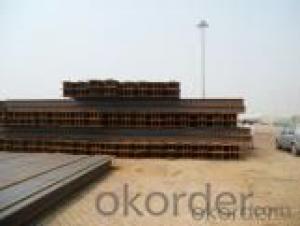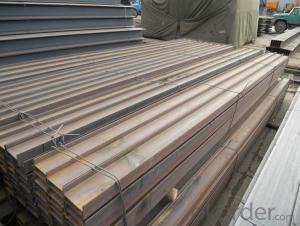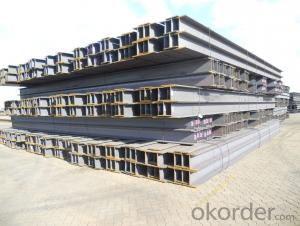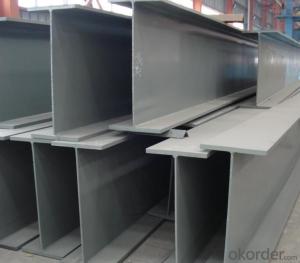H-Beam Structure Steel -JIS Standard GB Standard
- Loading Port:
- Tianjin
- Payment Terms:
- TT or LC
- Min Order Qty:
- 50 m.t.
- Supply Capability:
- 50000 m.t./month
OKorder Service Pledge
OKorder Financial Service
You Might Also Like
Product Description:
OKorder is offering H-Beam Structure Steel -JIS Standard GB Standard at great prices with worldwide shipping. Our supplier is a world-class manufacturer of steel, with our products utilized the world over. OKorder annually supplies products to European, North American and Asian markets. We provide quotations within 24 hours of receiving an inquiry and guarantee competitive prices.
Product Applications:
H-Beam Structure Steel -JIS Standard GB Standard are ideal for structural applications and are widely used in the construction of buildings and bridges, and the manufacturing, petrochemical, and transportation industries.
Product Advantages:
OKorder's H-Beam Structure Steel -JIS Standard GB Standard are durable, strong, and resist corrosion.
Main Product Features:
· Premium quality
· Prompt delivery & seaworthy packing (30 days after receiving deposit)
· Corrosion resistance
· Can be recycled and reused
· Mill test certification
· Professional Service
· Competitive pricing
Product Specifications:
Specifications of Hot Rolled Structural Steel H Beam
1. Standard: GB700-88, Q235B2.
2. Grade: Q235, SS400 or Equivalent
3. Length: 6m,10m, 12m as following table
4. Invoicing on theoretical weight or actual weight as customer request
5.Payment: TT or L/C
6. Sizes:
SIZE(mm) | DIMENSION(kg/m) |
100*100 | 16.9 |
125*125 | 23.6 |
150*75 | 14 |
150*150 | 31.1 |
148*100 | 20.7 |
198*99 | 17.8 |
200*100 | 20.9 |
248*124 | 25.1 |
250*125 | 29 |
Usage & Applications of Hot Rolled Structural Steel H Beam
Commercial building structure ;Pre-engineered buildings; Machinery support structure; Prefabricated structure; Medium scale bridges; Ship-building structure. etc.
Packaging & Delivery of Hot Rolled Structural Steel H Beam
1. Packing: it is nude packed in bundles by steel wire rod
2. Bundle weight: not more than 3.5MT for bulk vessel; less than 3 MT for container load
3. Marks:
Color marking: There will be color marking on both end of the bundle for the cargo delivered by bulk vessel. That makes it easily to distinguish at the destination port.
Tag mark: there will be tag mark tied up on the bundles. The information usually including supplier logo and name, product name, made in China, shipping marks and other information request by the customer.
If loading by container the marking is not needed, but we will prepare it as customer request.
4. Transportation: the goods are delivered by truck from mill to loading port, the maximum quantity can be loaded is around 40MTs by each truck. If the order quantity cannot reach the full truck loaded, the transportation cost per ton will be little higher than full load.
5. Delivered by container or bulk vessel
Production flow of Hot Rolled Structural Steel H Beam
Material prepare (billet) —heat up—rough rolling—precision rolling—cooling—packing—storage and transportation
FAQ:
Q1: Why buy Materials & Equipment from OKorder.com?
A1: All products offered byOKorder.com are carefully selected from China's most reliable manufacturing enterprises. Through its ISO certifications, OKorder.com adheres to the highest standards and a commitment to supply chain safety and customer satisfaction.
Q2: How do we guarantee the quality of our products?
A2: We have established an advanced quality management system which conducts strict quality tests at every step, from raw materials to the final product. At the same time, we provide extensive follow-up service assurances as required.
Q3: How soon can we receive the product after purchase?
A3: Within three days of placing an order, we will begin production. The specific shipping date is dependent upon international and government factors, but is typically 7 to 10 workdays.
Q4: What makes stainless steel stainless?
A4: Stainless steel must contain at least 10.5 % chromium. It is this element that reacts with the oxygen in the air to form a complex chrome-oxide surface layer that is invisible but strong enough to prevent further oxygen from "staining" (rusting) the surface. Higher levels of chromium and the addition of other alloying elements such as nickel and molybdenum enhance this surface layer and improve the corrosion resistance of the stainless material.
Q5: Can stainless steel rust?
A5: Stainless does not "rust" as you think of regular steel rusting with a red oxide on the surface that flakes off. If you see red rust it is probably due to some iron particles that have contaminated the surface of the stainless steel and it is these iron particles that are rusting. Look at the source of the rusting and see if you can remove it from the surface.
Images:
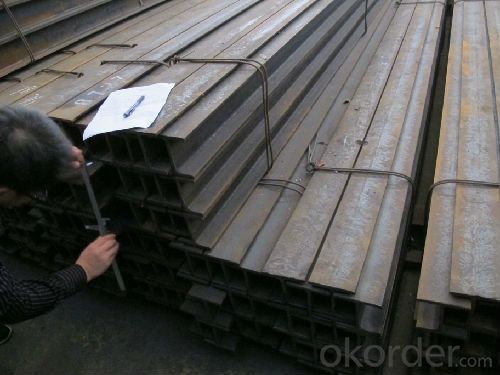
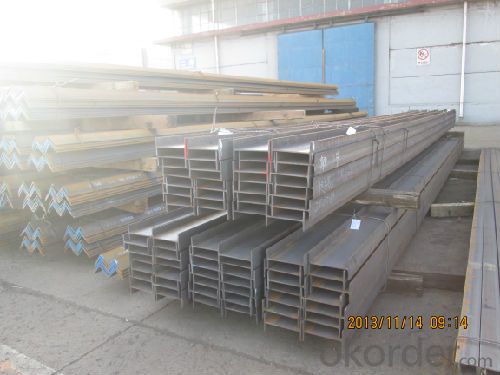

- Q: Are steel H-beams available in different finishes or coatings?
- Steel H-beams come in a variety of finishes and coatings. The most commonly used finishes or coatings for steel H-beams are galvanized, primed, and painted. Galvanized H-beams are coated with a layer of zinc to protect against rust and corrosion. This finish is perfect for outdoor or high-moisture settings. Primed H-beams are coated with a layer of primer, which creates a smooth surface for painting. This finish allows for customization with different paint colors and is often used indoors. Painted H-beams are coated with a layer of paint, providing both protection against corrosion and a visually pleasing appearance. Different paint colors can be chosen to match the desired design or style. Furthermore, there are specialized coatings available for steel H-beams, such as fire-resistant or anti-slip coatings, which cater to specific requirements or safety concerns in certain applications. In summary, the availability of different finishes or coatings for steel H-beams allows for customization and guarantees their durability and longevity in various environments.
- Q: Can steel H-beams be used in the construction of educational campuses or universities?
- Yes, steel H-beams can be used in the construction of educational campuses or universities. Steel H-beams are commonly used in construction due to their strength, durability, and versatility. They offer excellent structural support, allowing for the construction of large and open spaces such as lecture halls, libraries, or gymnasiums. Additionally, steel H-beams can be easily fabricated and installed, making them a suitable choice for educational campus construction projects.
- Q: Are there any safety concerns related to steel H-beams?
- Yes, there can be safety concerns related to steel H-beams. These concerns primarily revolve around the proper design, fabrication, and installation of the H-beams. If not done correctly, there is a risk of structural failure, which can lead to accidents, collapses, or injuries. Regular inspections, maintenance, and adherence to building codes and safety regulations are crucial to ensure the safe use of steel H-beams.
- Q: Can steel H-beams be used in museum and art gallery construction?
- Yes, steel H-beams can be used in museum and art gallery construction. Steel H-beams are commonly used as structural elements in building construction due to their strength and durability. They provide excellent support for large spans and heavy loads, making them suitable for creating expansive and open exhibition spaces in museums and art galleries.
- Q: Does the cross section of corrugated steel H have this section in PKPM?
- H type steel corrugated webs, by corrugated webs and the upper and lower flange, flange and bottom flange plate in parallel or at some angle, corrugated webs perpendicular to the flange between the side fillet weld may be double fillet, depending on the corrugated web thickness and welding process decision
- Q: What are the common applications of steel H-beams?
- Steel H-beams have a wide range of uses in the construction industry, particularly in structural and civil engineering. Some common applications of steel H-beams include: 1. Building Construction: Steel H-beams are frequently utilized as load-bearing elements in building construction and other structures. They offer exceptional strength and stability, making them ideal for supporting heavy loads and withstanding various forces like wind and earthquakes. 2. Bridges: Steel H-beams are extensively employed in bridge construction due to their ability to endure high loads and support large spans. They are commonly used as primary girders and piers, providing the necessary structural support to ensure bridge stability and durability. 3. Industrial Structures: Steel H-beams are commonly employed in the construction of industrial structures like warehouses, factories, and power plants. These structures often require large open spaces without the need for intermediate columns, and steel H-beams can provide the necessary strength and rigidity to meet these requirements. 4. Mezzanine Floors: Mezzanine floors are intermediate floors constructed within buildings to create additional usable space. Steel H-beams are frequently used to support these floors due to their ability to efficiently bear the weight of added loads and allow for flexible space utilization. 5. Platforms and Walkways: Steel H-beams are often utilized in constructing platforms and walkways in industrial settings such as oil refineries, chemical plants, and power stations. These structures demand high strength and stability to ensure worker and equipment safety, and steel H-beams are well-suited for this purpose. 6. Steel Frames: Steel H-beams are an integral part of constructing steel frames for various structures. They act as the skeleton of the building, providing the necessary support and stability to the overall structure. 7. Architectural Applications: Steel H-beams are also used in architectural applications to create unique and visually appealing structures. They can serve as decorative elements like exposed beams and columns, enhancing the visual appeal of buildings. In conclusion, steel H-beams have diverse applications in the construction industry, including building construction, bridges, industrial structures, mezzanine floors, platforms and walkways, steel frames, and architectural designs. Their strength, stability, and versatility make them an indispensable component in various construction projects.
- Q: Can steel H-beams be used in the construction of theaters or auditoriums?
- Certainly! Steel H-beams have proven to be a valuable asset in the construction of theaters and auditoriums. Their strength and durability make them a popular choice in the industry. These beams offer structural support and are frequently utilized as load-bearing components in various building projects. In the case of theaters and auditoriums, where expansive open spaces and lofty ceilings are often desired, steel H-beams can be employed to establish the necessary framework and provide support for the structure. Furthermore, these beams can be easily fabricated and tailored to meet the specific design and structural prerequisites of the theater or auditorium. Overall, steel H-beams are widely favored in the construction field due to their robustness, versatility, and dependability - qualities that make them particularly suitable for the construction of theaters and auditoriums.
- Q: Can steel H-beams be used in the construction of automotive or manufacturing plants?
- Yes, steel H-beams can be used in the construction of automotive or manufacturing plants. Steel H-beams are commonly used in industrial structures due to their high strength and load-bearing capacity. They provide structural support and stability, making them suitable for constructing large-scale facilities like automotive or manufacturing plants where heavy machinery and equipment are involved.
- Q: What are the factors to consider when selecting steel H-beams for a project?
- When selecting steel H-beams for a project, there are several important factors to consider. 1. Load-bearing capacity: The primary factor to consider is the load-bearing capacity of the H-beam. This includes both the dead load (the weight of the structure itself) and the live load (any additional weight that the structure may support). It is crucial to calculate the expected load and select a beam that can safely support it without deformation or failure. 2. Size and dimensions: The size and dimensions of the H-beam should be chosen based on the specific requirements of the project. The beam's height, width, and thickness will impact its load-carrying capacity and overall stability. It is essential to consult engineering and design guidelines to ensure the appropriate sizing for the project. 3. Material quality: The quality of the steel used in manufacturing the H-beams is crucial for the structural integrity and durability of the project. Factors such as the tensile strength, yield strength, and ductility of the steel should be considered. Higher grades of steel will generally have better strength properties, but they may come at a higher cost. 4. Corrosion resistance: Depending on the project's environmental conditions, it may be necessary to consider the corrosion resistance of the steel H-beams. If the structure will be exposed to moisture, chemicals, or other corrosive elements, selecting a beam with appropriate coatings or using stainless steel may be necessary to prevent deterioration and maintain the structural integrity over time. 5. Fabrication and installation requirements: The ease of fabrication and installation of the H-beams should also be taken into account. Consider factors such as the beam's shape, weight, and connection methods. Some projects may require pre-cut or pre-drilled beams for specific installation requirements, and these factors should be considered during the selection process. 6. Cost: Finally, the cost of the H-beams should be considered while balancing the project's budget with the desired quality and performance. Comparing prices from different suppliers and considering long-term costs, such as maintenance and replacement, can help make an informed decision. Overall, selecting steel H-beams for a project involves careful consideration of load-bearing capacity, size and dimensions, material quality, corrosion resistance, fabrication and installation requirements, and cost. Consulting with structural engineers and adhering to relevant building codes and standards is essential to ensure the safety and success of the project.
- Q: Can steel H-beams be used in industrial buildings?
- Yes, steel H-beams are commonly used in industrial buildings due to their strength, durability, and versatility. They provide excellent structural support and can withstand heavy loads, making them ideal for large-scale industrial construction projects.
Send your message to us
H-Beam Structure Steel -JIS Standard GB Standard
- Loading Port:
- Tianjin
- Payment Terms:
- TT or LC
- Min Order Qty:
- 50 m.t.
- Supply Capability:
- 50000 m.t./month
OKorder Service Pledge
OKorder Financial Service
Similar products
Hot products
Hot Searches
Related keywords




